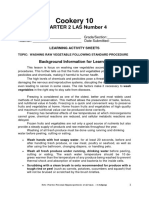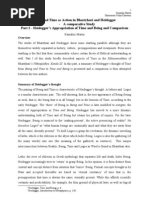Cookery 10 Quarter 2 Las No. 8
Cookery 10 Quarter 2 Las No. 8
Uploaded by
jamesCopyright:
Available Formats
Cookery 10 Quarter 2 Las No. 8
Cookery 10 Quarter 2 Las No. 8
Uploaded by
jamesCopyright
Available Formats
Share this document
Did you find this document useful?
Is this content inappropriate?
Copyright:
Available Formats
Cookery 10 Quarter 2 Las No. 8
Cookery 10 Quarter 2 Las No. 8
Uploaded by
jamesCopyright:
Available Formats
Cookery 10
QUARTER 2 LAS Number 8
Name of Learner: Grade/Section:
Teacher: _________________________ Date Submitted:
LEARNING ACTIVITY SHEETS
TOPIC: Preparation of Sauces and Accompaniment for
Serving Vegetable Dishes
Background Information for Learners
Sauce is a term used in cookery to describe a wide range of flavoured liquids
that are served as part of the meal, or dish. The addition of a sauce to a particular dish
can transform the overall presentation of it.
Sauces come in a variety of styles and consistencies. They can be thick or thin,
rich and creamy, or light and delicate. Depending on the purpose, sauces can be
strongly flavored, hot and spicy, or even sweet to be served with a dessert.
Accompaniments on the other hand are highly flavored seasonings of various
kinds offered with certain dishes. The purpose is to improve the flavor of the food or
to counteract its richness or texture.
Healthy methods of cooking are those that do not require adding fat and are
quick cooking methods. Cooking vegetables by steaming in a pot or in the microwave;
grilling in a grill basket; boiling, or baking are all fat free methods of cooking
vegetables. Stir frying with a small amount of oil is yet another healthy way to cook
vegetables. These methods also allow nutrients to stay in the food instead of leaching
out into the water if you were to cook vegetables in a large pot of water for several
hours.
Many vitamins and other valuable nutrients will leach into water when food is
cooked in large amounts of water. So if you want to preserve nutrient loss in your foods
the best cooking methods will be where a minimum amount of water is used or no
water is used.
Sauces are the height of a chef’s achievement requiring study and practice to
master. A great saucier must have a discriminating palate and the ability to understand
how to build a depth and harmony into a sauce.
The formal study of sauces usually begins with the classic French sauces.
Today, however, world influences from Asia, Latin America, Africa and the
Mediterranean, along with the public’s appetite for new and exciting tastes, has driven
sauces in many different directions, and brought an array of flavors and endless
possibilities to their preparation and pairing.
Note: Practice Personal Hygiene protocols at all times. – M.Huliganga 1
The French term sauce is derived from the Latin word salus which means
salted. For Italians and Spanish people, they call it salsa. Sauces are meant to enjoy
and compliment foods, and make them more interesting to eat. They pull together
different elements of a dish to compliment or provide a contrast in flavors and textures.
Some sauces like a classic demi-glace, take days to prepare, while others, including
vinaigrette can be made very quickly. Sauces can be as simple as thickened pan
juices, or as complex as a Mexican mole or an Indian curry.
Sauce preparation used to involve a laborious and time consuming
commitment, and while this is still the case for preparation of classic French sauces,
the reality is that in today’s kitchen, very few operations prepare and use them as
originally intended. The reasons these sauces have grown out of favour, include the
changing preferences of chefs and the clientele they serve, the time factor involved in
their preparation, and the cost of producing them. In today’s world, food cost
economics, the desire for workplace efficiency, and lack of skill have created
convenience sauces, and shortcuts that produce adequate results to time-tested
methods that have evolved over centuries of practice.
History of sauces
Records of sauces dating from around 200 AD and attributed to Apicius, an
authoritative text of cooking from ancient Roman, include highly seasoned
preparations of herbs, spices, vinegar, honey and a form of fermented fish sauce
called garum.
These sauces were usually prepared with a mortar and pestle and are
thickened with pounded rice, nuts or bread. From the Roman times up to the
Middle Ages, dating around the 14th century, European sauce preparation does
not appear to have changed much. Garum, a fish sauce gave way to vinegar and
verjus as a flavouring, and almonds on the other hand, were used to thicken them.
During the crusades, exotic spices from the Middle East came into popular demand.
Earlier in the 15th century, chefs began to learn about the benefits of reducing sauces
to concentrate flavors by simmering them on the stove. They also learned about
clarification and straining sauces to get better texture and smoothness.
6 types of basic sauces
1. Mayonnaise – is a cold sauce made with eggs and olive oil. This is best used
as dressings for salads and also goes well with sandwiches and the traditional fish
and chips.
https://www.google.com/search?q=images-+forms+of+mayonnaise&tbm=
Note: Practice Personal Hygiene protocols at all times. – M.Huliganga 2
2. Hollandaise – is a warm sauce made with butter and eggs, seasoned with white
vinegar and peppercorns. It is popular with steaks and vegetables like broccoli and
cauliflower.
https://www.google.com/search?q=images-+hollandaise&tbm=
3. Tomato Sauce – are made with tomatoes and gives authentic flavour to
recipes. This is used in traditional ham and bacon, specifically using tomato puree.
https://www.google.com/search?ei=EhIZX5q5AoH2wAPhm7rgAg&q=images-+tomato+sauce&oq=
4. Brown Sauce – is also called as espagnole, which is made with a meat stock,
done by simmering it for hours until it reduces to a thick, rich brown sauce. This
particular sauce is the perfect accompaniment for grilled or roasted red meat.
https://www.google.com/search?ei=fTIZX6fuG5CJmAX5nayACQ&q=images-+brown+sauce&oq=
5. Veloute – is made with a roux of flour and butter. This is good for white meats
and perfect for continental cuisine.
Note: Practice Personal Hygiene protocols at all times. – M.Huliganga 3
https://www.google.com/search?ei=tDIZX7q3POGKr7wP8p64uAU&q=images-+veloute+sauce&oq
6. Bechamel – is also a roux made of milk flavoured with nutmeg. This sauce goes
well with lasagne, cannel oni and casserole dishes.
https://www.google.com/search?ei=3zIZX8W8DtCtoATXh7PwCQ&q=images-+bechamel+sauce&oq=
LEARNING ACTIVITY 1: Creating a mind web on the kinds of sauces.
Direction: To start the lesson with sauces, please do the activity below. Fill it with the
six kinds of sauces. Write your answers in your activity notebook.
Note: Practice Personal Hygiene protocols at all times. – M.Huliganga 4
LEARNING ACTIVITY 2:
Identifying some facts about sauces and accompaniments used in serving vegetable
dishes.
Direction: Tell whether the statement is true or false. Write T if the statement is
TRUE and letter F if not true. Use your quiz notebook for your answer.
___1. Bechamel is a sauce made with a roux and milk flavoured with nutmeg.
___2. The brown sauce is also called as espagnole.
___3. Brown sauce is the perfect accompaniment for grilled or roasted
red meat.
___4. Almonds are used to thicken vinegar and verjus as a flavouring.
___5. Exotic spices from the Middle East became popular and in demand
during the crusades.
___6. Sauces are not laborious to prepare.
___7. Salsa is the French term for sauce.
___8. Salus is the term for sauces in Spanish and Italian.
___9. The formal study of sauces started with the African sauces.
seeds, skins or shells.
____10. The person involved in the production of sauces is called chef.
LEARNING ACTIVITY 3:
Direction: Let us check how much you learned about the lesson on vegetable
sauces. Answer the questions below and write only the letter of your answer in your
quiz notebook.
1. The addition of this to a particular vegetable dish can transform its overall
presentation
a. accompaniment c. flavor
b. taste d. sauce
2. It is a side dish which complements the food.
a. texture c. sauce
b. flavor d. food accompaniment
3. It helps in enhancing the flavour and taste of dishes.
a. texture c. taste
b. aroma d. food accompaniment
4. This does not require adding fat.
a. food accompaniment c. sauces
b. valuable nutrients d. healthy methods
5. The cooking activity in which preservation of nutrients is done.
a. 1 is to 1 ratio c. more heat
b. use of more water d. use of minimum water
6. He must have a discriminating palate and the ability to understand how to build
and harmony into a sauce.
a. chef c. saucier
b. cook d. baker
Note: Practice Personal Hygiene protocols at all times. – M.Huliganga 5
7. This is an ingredient that is cooked for a different amount of time to produce a
lighter or darker color for the purpose of thickening the sauce.
a. salus c. roux
b. garum d. demi-glace
8. 8. The term for sauces in Spanish and Italian.
a. roux c. salsa
b. espagnole d. garum
9. This is an authoritative text of cooking from ancient Roman which include the
highly seasoned preparations containing herbs, spices, vinegar, honey, and a
form of fermented fish sauce.
a. Garum c. Apicus
b. Espagnole d. Salsa
10. This is a fermented fish sauce.
a. salsa c. garum
b. verjus d. espagnole
LEARNING ACTIVITY 4:
Note: Practice Personal Hygiene protocols at all times. – M.Huliganga 6
You might also like
- MasterCard File Express Client Users GuideDocument48 pagesMasterCard File Express Client Users GuideJuan100% (1)
- Saa6d170e-3 Engine PDFDocument90 pagesSaa6d170e-3 Engine PDFamin100% (4)
- Tle10 - He - Cookery - q2 - Mod1 - Performmiseenplace - v3 (70 Pages) PDFDocument70 pagesTle10 - He - Cookery - q2 - Mod1 - Performmiseenplace - v3 (70 Pages) PDFLyz merin100% (11)
- 10 COOKERY Q2M6tle10 He Cookery q2 Mod5 Evaluatingthefinishedproduct v3 (50 Pages)Document54 pages10 COOKERY Q2M6tle10 He Cookery q2 Mod5 Evaluatingthefinishedproduct v3 (50 Pages)Rd David100% (2)
- Gatsby False Prophet of The American Dream EssayDocument2 pagesGatsby False Prophet of The American Dream EssayKarichmarie Marrero RodriguezNo ratings yet
- Final Cookery 10 q1 Module 5Document23 pagesFinal Cookery 10 q1 Module 5Lailani Romero100% (1)
- TlE 10 2nd Quarter Module 4Document3 pagesTlE 10 2nd Quarter Module 4VernaNo ratings yet
- Tle 10 Household Quarter 1 Module 8 Calledo GoDocument26 pagesTle 10 Household Quarter 1 Module 8 Calledo GoErvis BahintingNo ratings yet
- Cookery 10 Q3 Week 3Document10 pagesCookery 10 Q3 Week 3Ivy Salazar100% (2)
- G10 Exam 2ND Quarter TleDocument6 pagesG10 Exam 2ND Quarter TleFLORAME OÑATENo ratings yet
- 10-COOKERY-Q2M3-Tle10 He Cookery q2 Mod3 Presentingvegetabledishes V3-44-PagesDocument45 pages10-COOKERY-Q2M3-Tle10 He Cookery q2 Mod3 Presentingvegetabledishes V3-44-PagesJennifer CarpioNo ratings yet
- He Cookery Gr10 q2 Module5Document19 pagesHe Cookery Gr10 q2 Module5Sahar Fatmah DagadasNo ratings yet
- Q3 Module2 G10 COOKERYDocument10 pagesQ3 Module2 G10 COOKERYJayzi VicenteNo ratings yet
- Quarter 2 Lesson 4 5 Plate and Present Seafoods Shirleybantiguedulay 1Document12 pagesQuarter 2 Lesson 4 5 Plate and Present Seafoods Shirleybantiguedulay 1Joseph Jucons C. SantosNo ratings yet
- Tle 10 - Cookery Quarter 2 Module 2Document27 pagesTle 10 - Cookery Quarter 2 Module 2vanngodolieveNo ratings yet
- Grade10-Cookery Sim7Document19 pagesGrade10-Cookery Sim7Unknown Engr.No ratings yet
- QTR 1 Cookery 10 Module 4Document18 pagesQTR 1 Cookery 10 Module 4JOANNA ADRIANONo ratings yet
- LO3Sources of StarchDocument18 pagesLO3Sources of StarchBian CaNo ratings yet
- Tle Cookery9 Q4 Mod7Document17 pagesTle Cookery9 Q4 Mod7lea florNo ratings yet
- Week 2 TLE 10Document7 pagesWeek 2 TLE 10Jenneth B. RapistaNo ratings yet
- Food Technology 10 Cookery 10/: Self-Learning Module 1 Mise en PlaceDocument12 pagesFood Technology 10 Cookery 10/: Self-Learning Module 1 Mise en PlaceMark PandilNo ratings yet
- Cookery 10 2ndQ Module 2Document69 pagesCookery 10 2ndQ Module 2Pio E. Barretto Jr.No ratings yet
- Tle 10-Cookery Quarter II - Week 7Document14 pagesTle 10-Cookery Quarter II - Week 7Samantha MusniNo ratings yet
- Tle10 - He - Cookery - q2 - Mod6 - Preparingandcookingseafooddishes - v3 (91 Pages) - 2Document92 pagesTle10 - He - Cookery - q2 - Mod6 - Preparingandcookingseafooddishes - v3 (91 Pages) - 2Ian Grace Dolar FabianiaNo ratings yet
- Grade 10Document22 pagesGrade 10Kae-c Lyn Nueva-Limbo Garcia100% (2)
- TLE Cookery 10 Q2 Week 3Document10 pagesTLE Cookery 10 Q2 Week 3CatherinerNo ratings yet
- Functional Properties of StarchesDocument14 pagesFunctional Properties of StarchesHappie Dilao100% (1)
- Tle 10 Cookery Quarter 2 Module 3 Arabis 1Document16 pagesTle 10 Cookery Quarter 2 Module 3 Arabis 1Suico, Agnes Catherine100% (1)
- Grade 10 q2 Module 2 Cookery EditedDocument33 pagesGrade 10 q2 Module 2 Cookery Editedjeanette hijadaNo ratings yet
- Tle 10 Household Quarter 1 Module 7Document32 pagesTle 10 Household Quarter 1 Module 7Efielyn QuimNo ratings yet
- Standardized Recipe of TLE CookeryDocument4 pagesStandardized Recipe of TLE CookeryAndrei Saga100% (1)
- Arts-10 2Q 2aDocument19 pagesArts-10 2Q 2aKyzia MichaelaNo ratings yet
- Cookery 10 3RD QuarterDocument87 pagesCookery 10 3RD QuarterKrison Jake Articulo100% (1)
- COOKERY 10 Quarter 3 LAS Number 1Document6 pagesCOOKERY 10 Quarter 3 LAS Number 1Constancia Perez100% (1)
- Q3 Module3 G10 COOKERYDocument7 pagesQ3 Module3 G10 COOKERYJayzi Vicente100% (3)
- TLE 10 Cookery: ReviewerDocument4 pagesTLE 10 Cookery: ReviewerDan Rey OsiasNo ratings yet
- Cookery 10 Quarter 2 Las No. 14Document22 pagesCookery 10 Quarter 2 Las No. 14VallerieNo ratings yet
- Lesson 6 Tle-10 - 2nd-GradingDocument53 pagesLesson 6 Tle-10 - 2nd-GradingJean Jean NasayaoNo ratings yet
- Tle10 He Cookery q2 Mod4 Storingvegetabledishes v3 (62 Pages)Document53 pagesTle10 He Cookery q2 Mod4 Storingvegetabledishes v3 (62 Pages)Marilyn Lamigo BristolNo ratings yet
- Grade 10: Tle - He (Cookery 10) Quarter 1 - Prepare Egg Dishes Module 2-Prepare and Cook Egg DishesDocument12 pagesGrade 10: Tle - He (Cookery 10) Quarter 1 - Prepare Egg Dishes Module 2-Prepare and Cook Egg DishesTIPAY, EMELIE L.100% (1)
- LAS Cookery10 q3 Week1 FinalDocument13 pagesLAS Cookery10 q3 Week1 FinalMaria Rose Tariga AquinoNo ratings yet
- COOKERY 10 Quarter 2 LAS No. 4Document4 pagesCOOKERY 10 Quarter 2 LAS No. 4Chema Paciones100% (3)
- Final Cookery 9 Q4 Module1Document15 pagesFinal Cookery 9 Q4 Module1JELANY AQUINO100% (1)
- Q2 G10 W4 Essential Factors of Food Presentation and Plating StylesDocument51 pagesQ2 G10 W4 Essential Factors of Food Presentation and Plating StylesFortunato de Guzman100% (1)
- COOKERY 10 Quarter 2 LAS No. 5Document5 pagesCOOKERY 10 Quarter 2 LAS No. 5Chema Paciones100% (2)
- Selecting Good Quality Poultry and GameDocument11 pagesSelecting Good Quality Poultry and GameCheriel Alcala Calledo100% (1)
- Tle10 2ND Quarter Module 2Document4 pagesTle10 2ND Quarter Module 2VernaNo ratings yet
- Final Cookery10 q4 Module 4Document16 pagesFinal Cookery10 q4 Module 4eda gadoyNo ratings yet
- Guidelines For Baking FishDocument13 pagesGuidelines For Baking FishLoraineTenorioNo ratings yet
- Cookery 9: 4 Quarter Week 4Document8 pagesCookery 9: 4 Quarter Week 4Michelle Ann LuzonNo ratings yet
- COOKERY 10 Quarter 2 LAS No. 1Document9 pagesCOOKERY 10 Quarter 2 LAS No. 1Chema PacionesNo ratings yet
- Household-Services-Lm-G10-Jonhs FinalDocument86 pagesHousehold-Services-Lm-G10-Jonhs FinalFlorinda Gagasa100% (1)
- Cookery9 Q2 Mod1 Lesson1-2 PrepareSaladandDressing V4-2Document52 pagesCookery9 Q2 Mod1 Lesson1-2 PrepareSaladandDressing V4-2Ian Grace Dolar FabianiaNo ratings yet
- Grade 10: Presenting Vegetable DishesDocument10 pagesGrade 10: Presenting Vegetable DishesStary Erman Kendrick MarkNo ratings yet
- Learning Outcome 4 Store Starch and Cereal DishesDocument6 pagesLearning Outcome 4 Store Starch and Cereal Dishesloiz eliseoNo ratings yet
- Quarter 1 - Module 4: CookeryDocument21 pagesQuarter 1 - Module 4: CookeryJonnavell Real100% (1)
- Cereal and Starch (TLE 10)Document9 pagesCereal and Starch (TLE 10)SKS100% (1)
- Lesson 1: Preparing Fish and Seafood Dishes A. Seafood: Definition, Types, and CharacteristicsDocument17 pagesLesson 1: Preparing Fish and Seafood Dishes A. Seafood: Definition, Types, and CharacteristicsReygina Mae Sibayan Palaganas100% (3)
- Market Forms of FishDocument12 pagesMarket Forms of FishAntonette OcampoNo ratings yet
- Lesson 5-Tle 10-2ND QuarterDocument16 pagesLesson 5-Tle 10-2ND QuarterJean Jean NasayaoNo ratings yet
- 1PPTGR10-Tools, Utensils and Equipment Needed in EggDocument23 pages1PPTGR10-Tools, Utensils and Equipment Needed in EggLenLen PeñafloridaNo ratings yet
- Week 6 Modules in Tle 10Document6 pagesWeek 6 Modules in Tle 10Israel MarquezNo ratings yet
- Sptve-Cookery Preparing Vegetable Dishes: Guided Learning Activity KitDocument15 pagesSptve-Cookery Preparing Vegetable Dishes: Guided Learning Activity KitLucille PaglingayenNo ratings yet
- Big Data Analytics in Telecommunications: Literature Review and Architecture RecommendationsDocument22 pagesBig Data Analytics in Telecommunications: Literature Review and Architecture RecommendationsImam SudrajatNo ratings yet
- MAXON CINEMA 4D R18 Studio A Tutorial Approach 5th Edition Sham Tickoo All Chapters Instant DownloadDocument65 pagesMAXON CINEMA 4D R18 Studio A Tutorial Approach 5th Edition Sham Tickoo All Chapters Instant Downloaddeylestomagp100% (1)
- Kohlberg'S Theory of Moral DevelopmentDocument10 pagesKohlberg'S Theory of Moral Developmentkc osayan100% (1)
- LEISA 20 4 Farming With NatureDocument36 pagesLEISA 20 4 Farming With NatureLoznjakovic NebojsaNo ratings yet
- Dissertation Scope of ResearchDocument8 pagesDissertation Scope of ResearchCustomPapersOnlineCanada100% (1)
- state-board-textbook-class-11th-environmentalDocument85 pagesstate-board-textbook-class-11th-environmentalUkunal KunalNo ratings yet
- Venue GO BroaucherDocument8 pagesVenue GO BroaucherSanjeev Kumar YadavNo ratings yet
- Formulation of A Novel Herbal Based Liniment For Muscle Aches and PainDocument6 pagesFormulation of A Novel Herbal Based Liniment For Muscle Aches and PainMr.S. p.royNo ratings yet
- WMM Tarring EstDocument7 pagesWMM Tarring EstMahin ThaliyathNo ratings yet
- Alumni Management SystemDocument33 pagesAlumni Management SystemE20CA053Santhosh V100% (1)
- About Godrej LockDocument13 pagesAbout Godrej LockVivek MalaniNo ratings yet
- Pertemuan 11 Metodologi PenelitianDocument3 pagesPertemuan 11 Metodologi PenelitianAdji LanangNo ratings yet
- The Effect of Mobile-Wallet Service Dimensions On Customer Satisfaction and Loyalty An Empirical StudyDocument19 pagesThe Effect of Mobile-Wallet Service Dimensions On Customer Satisfaction and Loyalty An Empirical StudyMuhamad Andi WicaksonoNo ratings yet
- Bitbus Open Technical MeetingDocument10 pagesBitbus Open Technical MeetingRENZHI LINo ratings yet
- SOSCG 6jul2013 v5Document32 pagesSOSCG 6jul2013 v5Suhazeli Abdullah100% (2)
- Wilbur Smith Traffic - Study - 2009Document215 pagesWilbur Smith Traffic - Study - 2009Terry MaynardNo ratings yet
- Acceptance Criteria-Asme Section 5Document18 pagesAcceptance Criteria-Asme Section 5HAKAN75% (4)
- Criminal Complaint Against Neysa Fligor and MaryAnn Barry For PerjuryDocument33 pagesCriminal Complaint Against Neysa Fligor and MaryAnn Barry For PerjuryJames Alan BushNo ratings yet
- Bhartrhari HeideggerDocument9 pagesBhartrhari Heideggerkmartin8181No ratings yet
- Money Lesson SequenceDocument10 pagesMoney Lesson Sequenceapi-366373073No ratings yet
- Initial Data Base For Family Nursing PracticeDocument15 pagesInitial Data Base For Family Nursing PracticeLyka SaysonNo ratings yet
- 25 RandomthingsDocument1 page25 Randomthingsrzbackup1426No ratings yet
- CEPC+116-+Lesson+10 Fluid+Flow+in+PipesDocument19 pagesCEPC+116-+Lesson+10 Fluid+Flow+in+PipesLorence LatorzaNo ratings yet
- Translste Gebhar Scram - 11-35Document25 pagesTranslste Gebhar Scram - 11-35indra purnamaNo ratings yet
- PHD Thesis On Network Security PDFDocument7 pagesPHD Thesis On Network Security PDFamandasanchezalbuquerque100% (2)
- Elective PDFDocument4 pagesElective PDFRazvan ButiseacaNo ratings yet
- Input Output Devices AssignmentDocument6 pagesInput Output Devices Assignmentpubg broNo ratings yet

























































































